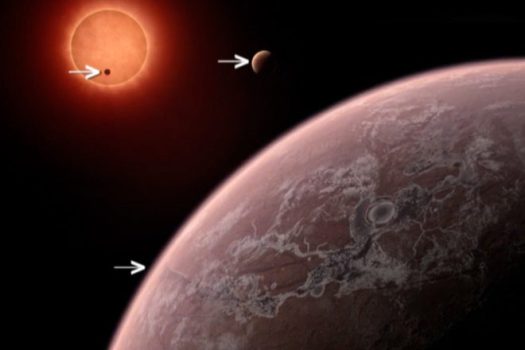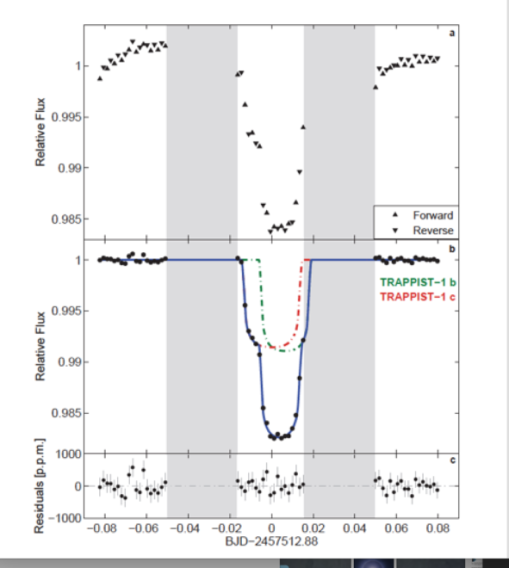
Forty light-years away is no small distance. But an announcement of the discovery of two planets at that separation that have been determined to be rocky and Earth-sized adds a significant new twist to the ever-growing collection of relatively close-by exoplanets that just might be habitable.
The two planets in the TRAPPIST-1 system orbit what is known as a red dwarf star, a type of star that is typically much cooler than the sun, emitting radiation in the infrared rather than the visible spectrum. While there has been much debate about whether an exoplanet around a dwarf can be deemed habitable, especially since they are all believed to be tidally locked and so only one side faces the star, a consensus appears to be growing that dwarf stars could host habitable planets.
The two new rocky exoplanets were detected using the Hubble Space Telescope and were deemed most likely rocky by the compact sizes of their atmospheres — which were not large and diffuse hydrogen/helium envelopes (like that of the Jupiter) but instead more tightly packed, more like the atmospheres of Earth, Venus, and Mars. It was the first time scientists have been able to search for and at least partially characterize of atmospheres around a temperate, Earth-sized planet.
Having determined that the planets are rocky, principal investigator Julien de Wit of M.I.T’s Department of Earth, Atmospheric and Planetary Sciences, said the goal now is to characterize their atmospheres.
“Now the question is, what kind of atmosphere do they have?” de Wit said. “The plausible scenarios include something like Venus, where the atmosphere is dominated by carbon dioxide, or an Earth-like atmosphere with heavy clouds, or even something like Mars with a depleted atmosphere. The next step is tomtry to disentangle all these possible scenarios that exist for these terrestrial planets.”

Host stars with exoplanets that are (very relatively) close to us are highly valued because they are potentially easier to observe and characterize.
There are 24 known exoplanets within 40 light-years, 14 are within 30 light-years, and only six are within 20 light-years. The closest exoplanet considered confirmed by NASA is Epsilon Eridani b, 10.5 light-years away from our solar system, while the closest known rocky planet is HD 219134 b, which is 21 light-years away.. Planetary companions have been suggested to exist in some of the nine star systems located within 10 light-years away, including in the closest system, Alpha Centauri (4.1 light-years away).
TRAPPIST-1 (planets b and c) are among the closest orbiting a red dwarf star, and they provided an unusual double transit to observe.
“The two planets actually transited their star just 12 minutes apart so we got two planets for the price of one,” said co-author Hannah Wakeford of NASA’s Goddard Space Flight Center. “This is the first time two planets have been characterized with Hubble at the same time on purpose, and the first time such small (Earth-sized) planets have had atmospheric follow-up done.”
The researchers hope to use Hubble to conduct follow-up observations to search for thinner atmospheres, composed of elements heavier than hydrogen, like those of Earth and Venus.
“With more data, we could perhaps detect methane or see water features in the atmospheres, which would give us estimates of the depth of the atmospheres,” she said.
The results were reported in the journal Nature.

TRAPPIST-1c double transit of 4 May 2016. (NASA/STScI)
There’s an interesting story behind their Hubble observation of the two transits. Using their relatively small telescope at the European Southern Observatory’s La Silla facility in Chile, the TRAPPIST-1 team detected the unusual three-planet system around the small, cool star and published their discovery a little more than two months ago.
Within days, they realized that planets b and c would be orbiting the star at almost exactly the same time — an unexpected and quite valuable occurrence. (Information about that double transit was provided via the Spitzer Space Telescope, which had also been studying the orbits of planets in the TRAPPIST-1 system.)
The upcoming double transit was confirmed but two weeks before the event. The team requested Hubble time for a quick observation, and it was granted. The successful observation soon followed.
DeWit said that planets with the sizes and equilibrium temperatures of TRAPPIST-1b and TRAPPIST-1c could possess relatively thick atmospheres with water, carbon dioxide, nitrogen and oxygen.
The TRAPPIST (TRAnsiting Planets and PlanetesImals Small Telescope) project is the creation in large part of the Origins in Cosmology and Astrophysics group of the University of Liege in Belgium.
The TRAPPIST instrument is new kind of ground telescope designed to survey the sky in infrared. TRAPPIST was built as a 60-centimeter prototype to monitor the 70 brightest dwarf stars in the southern sky. Now, the researchers have formed a consortium, called SPECULOOS (Search for habitable Planets Eclipsing ULtra-cOOl Stars), and are building four larger versions of the telescope in Chile, to focus on the brightest ultracool dwarf stars in the skies over the southern hemisphere. The researchers are also trying to raise money to build telescopes in the northern sky.

According to De Wit, he TRAPPIST telescopes are inexpensive compared with their peer — about $400,000 per instrument.
He is pushing to make them a relatively affordable “prescreening tool” that scientists can use to identify planets that are potentially habitable. The TRAPPIST observations would then be followed up by my detailed study using powerful telescopes such as Hubble and NASA’s James Webb Telescope, which is scheduled to launch in October 2018.
“With more observations using Hubble, and further down the road with James Webb, we can know not only what kind of atmosphere planets like TRAPPIST-1 have, but also what is within these atmospheres,” de Wit says. “And that’s very exciting.”
